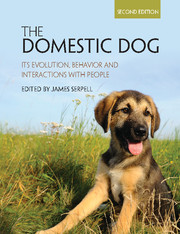Book contents
- Frontmatter
- Dedication
- Contents
- List of contributors
- 1 Introduction
- PART I ORIGINS AND EVOLUTION
- PART II BEHAVIOR, COGNITION AND TRAINING
- PART III DOG-HUMAN INTERACTIONS
- PART IV LIFE ON THE MARGINS
- 16 Variation in dog society: Between resource dispersion and social fl ux
- 17 The ecology and behavior of feral dogs: A case study from central Italy
- 18 Roaming free in the rural idyll: Dogs and their connections with wildlife
- 19 Dog population management
- 20 Epilogue: The tail of the dog
- Index
- Plate section
- References
16 - Variation in dog society: Between resource dispersion and social fl ux
from PART IV - LIFE ON THE MARGINS
Published online by Cambridge University Press: 30 December 2016
- Frontmatter
- Dedication
- Contents
- List of contributors
- 1 Introduction
- PART I ORIGINS AND EVOLUTION
- PART II BEHAVIOR, COGNITION AND TRAINING
- PART III DOG-HUMAN INTERACTIONS
- PART IV LIFE ON THE MARGINS
- 16 Variation in dog society: Between resource dispersion and social fl ux
- 17 The ecology and behavior of feral dogs: A case study from central Italy
- 18 Roaming free in the rural idyll: Dogs and their connections with wildlife
- 19 Dog population management
- 20 Epilogue: The tail of the dog
- Index
- Plate section
- References
Summary
Introduction
Domestic dogs, Canis familiaris, live in various degrees of association with people. Extremes of this continuum range from the lap dog to those living in uninhabited areas (Young et al., 2011) or islands (e.g. Kruuk & Snell, 1981). Dogs that are not strictly controlled by their owners might be expected to modify their behavior to match their ecological circumstances according to the same principles that affect wild Carnivora (e.g. Kruuk, 1975; MacDonald, 1983; MacDonald & Sillero-Zubiri, 2004) and free-ranging domestic ones such as cats, Felis catus (e.g. Daniels et al., 2001; Liberg et al., 2000; MacDonald et al., 1987). Therefore, we would expect that free-roaming dogs studied under different conditions would behave differently, and that these differences would be adaptive (in so far as artificial selection had not compromised the traits in question). This prediction, however, has not been formally tested (three studies explored variation in behavior amongst different free-roaming dogs – Bonanni et al., 2010a, 2010b; Mangalam & Singh, 2013). Studies of feral dogs in urban areas have tended to conclude that they form amorphous, and probably ephemeral associations (e.g. Beck, 1973; Daniels & Bekoff, 1989a). Furthermore, the questions of whether these associations are adapted to ecological circumstances and whether membership of groups has functional consequences have received little attention. Such questions have both theoretical and practical importance. The abundance, accessibility and potential manipulability of free-roaming dogs, combined with background knowledge of the genetic and physiological differences between breeds, make them strong candidates for testing ideas about canid socioecology. In addition, an understanding of dog behavior should help the design of control programs intended to counteract their potential as pests – whether as predators of stock or game, vectors of disease (e.g. rabies, distemper and Echinococcus; Bhunu, 2011; WHO, 1988), or as genetic contaminators of wild canid populations (see Boitani, 1983; Ginsberg & MacDonald, 1990; Hughes et al., Chapter 18). Finally, free-roaming dog behavior is interesting because of the opportunity it affords for comparison between breeds and with the ancestral wolf (Boitani & Ciucci, 1995), Canis lupus, and as part of the study of domestication (Driscoll et al., 2009; Scott & Fuller, 1965; Zimen, 1972).
We therefore compared the behavior of free-roaming dogs in contrasting ecological conditions in order to observe whether their social organization differed, and to determine whether their behavior matched predictions based on their ecology.
- Type
- Chapter
- Information
- The Domestic DogIts Evolution, Behavior and Interactions with People, pp. 319 - 341Publisher: Cambridge University PressPrint publication year: 2016
References
- 3
- Cited by



